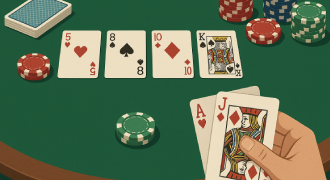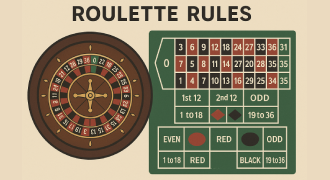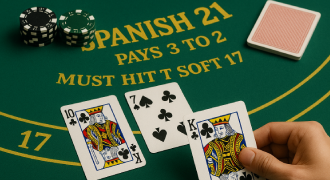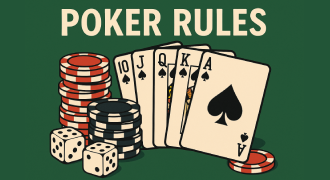Omaha Poker Guide: Rules, Hands, and Winning Tips
Fast-paced, multiway, and rich with draws, Omaha rewards structured thinking and calm execution under pressure. The casino game looks familiar to Hold’em players, yet the extra cards create combinational explosions that punish lazy shortcuts. Master equities, position, and disciplined hand selection, and you will find lines that capture value while sidestepping reverse implied traps. Many players first discover the thrill of deep pots through Omaha Poker.
Description of Omaha Poker
If you are completely new to Omaha, the first step is understanding the rigid requirement to use exactly two private cards with exactly three board cards to make your final five-card combination. Four hole cards invite creativity, but the fixed construction rule keeps results fair and creates elegant strategic trade-offs between raw equity and playability.
Position magnifies every advantage, and SPR (stack-to-pot ratio) controls how aggressively you should push medium-strength holdings. The question many newcomers ask is, what is Omaha Poker? It is a community-card variant where each player receives four private cards and must use precisely two of them at showdown. When people say Omaha Poker game, they usually refer to Pot-Limit Omaha (PLO), the most widely played betting structure for the variant.
Below is a table summarizing the key rules and structure of Omaha Poker for beginners. Use it as a quick reference guide to understand how hole cards, community cards, positions, and other basic aspects of the game work.
|
🔑 Aspect |
📖 Explanation |
|
🎯 Goal |
Make the best 5-card hand using exactly 2 hole cards + 3 community cards |
|
🃏 Hole Cards |
Each player gets 4 private cards |
|
🌐 Community Cards |
5 shared cards: Flop (3), Turn (1), River (1) |
|
💵 Blinds |
Forced bets to seed the pot (Small Blind, Big Blind) |
|
🔄 Positions |
Dealer button rotates; later positions = more information |
|
📊 Stack-to-Pot Ratio (SPR) |
Guides aggression on medium-strength hands |
|
🏆 Hand Assembly |
Must use 2 private + 3 community; 4 hole cards cannot be used all at once |
|
💡 Strategy Tip |
Focus on combo-draws, suited connectors, and nut hands |
|
🎲 Game Formats |
Pot-Limit Omaha (most common), PLO Hi-Lo, online & live tables |
Omaha Hi vs Omaha Hi-Lo (8 or Better)
Omaha Poker Hi awards the entire pot to the best high hand, while the Hi-Lo split variant divides the pot between the best high and a qualifying low, typically “eight or better.” In split games, proper low draws gain importance, and high-only monsters shrink in relative value because you may only earn half the pot. Always track board pairing and suit duplication, because split pots can quickly become three-way with both high and low contenders surviving to showdown.
Below is a table explaining the differences between Omaha Hi and Omaha Hi-Lo (8 or Better), including pot splitting rules, low hand rules, and strategic nuances.
|
🏆 Variant |
📖 Explanation / Key Points |
|
🔝 Omaha Hi |
Entire pot goes to the best high hand; standard hand rankings |
|
🔀 Omaha Hi-Lo (8 or Better) |
Pot splits between best high and qualifying low (≤8) |
|
💡 Low Hand Rules |
Only hands with 5 distinct cards ≤8 qualify |
|
⚖️ Strategic Impact |
High-only monsters shrink in value; low draws gain importance |
|
🃏 Board Considerations |
Track paired boards & suit duplication to predict multi-way split pots |
|
💵 Pot Management |
Adjust aggression based on potential for split vs full pots |
Essential Omaha Rules You Must Know
The golden rule is the two-and-three requirement, which drives everything from nut-hunting to bluff frequency. Because you cannot play the board, holdings that look strong in Hold’em—like trips from a single hole card—often fail in this format. Suitedness across your four cards matters, but double-suited hands and connected ranks tell a more complete story than random paint.
A concise overview of structure helps you avoid early mistakes with Omaha Poker rules. Beginners benefit from a clear view of Omaha Poker hand rankings tailored to this variant’s emphasis on nut straights and nut flushes.
Using Two Hole Cards Correctly
Misreading the two-card rule is the classic rookie error. For example, holding one heart does not make a flush when four hearts land on the board, and a set on board does not combine with one of your pocket pair cards to produce a full house unless the ranks align correctly. Always recount combinations when the board pairs or a third suited card appears, because your two-card requirement can both unlock disguised winners and invalidate wishful thinking you brought from Hold’em. When discussing table etiquette or procedural specifics in mixed games, some rooms summarize guidelines as poker omaha rules.
Pot-Limit Betting Explained
In PLO, the maximum raise is the size of the pot after your call, which creates natural caps that still leave plenty of leverage. Learning to count pot-size raises quickly is a valuable live skill, and online lobbies help by providing auto-sizing buttons. Pot geometry encourages aggression when stacks are shallow and caution when they are deep, so adjust your plan based on SPR before you commit chips on early streets. Players often cite the action and complexity of Omaha Poker as reasons they prefer the pot-limit format over fixed-limit or no-limit alternatives.
Step-by-Step Guide to Playing Omaha
Start preflop by filtering for connectivity, suitedness, and structure across all four cards. Double-suited rundowns (like J-10-9-8 with two suits) and high double-suited hands (such as A-K-Q-J with two suits) retain flexibility across many boards. On the flop, favor lines that chase the nuts or strong combo draws, because second-best results become expensive in PLO.
By the river, thin value remains but demands careful sizing and opponent selection. For newcomers seeking structure, many training sites explain how to play Omaha Poker with emphasis on nut equity and redraw potential.
Preflop to Showdown
Early position ranges should be tight and oriented around premium structures, while late position allows more speculative entries, especially with position on aggressive opponents. On the flop, evaluate whether your draws are to the nuts and whether they offer additional outs via backdoor straights or flushes.
The turn is where most money moves, so map raise sizes before your action to avoid pot-committing errors. At showdown, do not rush to table your hand; read the board and verify you are using exactly two hole cards first. A frequent beginner question is phrased as how do you play Omaha Poker, and the best short answer is to start tight, chase the nuts, and respect strong redraws.
Dealing Community Cards
The dealer follows the standard burn-and-turn procedure used in community-card games: deal four private cards to each seat, then reveal the flop, turn, and river with burns between streets. Protect your cards with a chip, track side pots carefully in multiway scenarios, and clarify bet sizes when stacks are deep.
As community cards arrive, re-evaluate blockers and redraws at each step because the number of viable combinations increases dramatically in this variant. Study materials often illustrate typical textures with examples of Omaha Poker hands that highlight nut flushes, wrap straight draws, and overset coolers.
Strategy Tips for Omaha Poker
Bias your selection toward structures that can make nut straights and nut flushes, and discount holdings that only make second-best outcomes. Respect position more than you did in Hold’em because visibility over multiple callers matters when equities run close. Use blockers to identify profitable bluff candidates on rivers that crush your perceived range, but avoid over-bluffing wet boards where call-downs are mathematically justified.
Many players fall in love with the energy of Omaha Poker, yet long-term winners show restraint when their draw is dominated or when reverse implied odds loom. Mobile study can be convenient, and some learners track combos and equity spots through an Omaha Poker app.
Key Differences Between Omaha and Texas Hold’em
With four hole cards, equities run closer and multiway pots are common, which dilutes the power of one-pair hands. Wraps and combo draws create frequent semi-bluff opportunities, but the price of chasing second-best is steep when stacks are deep. Because ranges broaden, game selection and seat selection carry outsized weight, and post-flop skill eclipses preflop edges. The pace and volume of seats across lobbies expose many to Omaha Poker online. Seasoned players often contrast these dynamics with the more straightforward rhythm of Omaha Poker.
Start Playing Omaha Poker Today
Build a simple preflop plan, practice equity estimates off-table, and choose games where stacks are deep enough to reward disciplined nut-hunting. Track your sessions, tag hands for review, and use focused drills that sharpen your turn and river decision-making. Keep tilt under control by defining stop-loss and stop-win limits before you sit, and stick to them even when the action is lively.
Newcomers often want to play Omaha Poker online.
Regulated platforms also host Omaha Poker online real money tables across a wide range of stakes.
|
🎰 Provider |
🎯 Paylines |
🔖 Paying Symbols |
🎁 Bonus Features |
🎲 RTP |
💵 Min Bet |
|
🌊 RiverRun Studio |
25 |
A, K, Q, J, 10; 🅰️ Wild Ace; 🏺 Scatter Pot |
🎡 Free Spins, 🃏 Sticky Wilds, ✨ Win Multipliers |
96.9% |
$0.20 |
RTP explanation: The RTP is 96.9%, meaning that across a very large sample, the game is expected to return $96.90 for every $100 wagered. Real sessions can deviate because variance produces clusters of wins and losses. The minimum bet is $0.20 per spin, which allows conservative testing of features before you scale stakes. Volatility trends medium-high, so plan sessions with defined budgets, use moderate bet progression, and avoid chasing losses after cold streaks.
FAQ
How many cards are dealt in Omaha?
Each seat receives four private cards, and you must use exactly two of them with three community cards to make your final five-card result.
What are the best starting hands?
Premiums include double-suited high rundowns like A-K-Q-J and connected middles like J-10-9-8 that produce nut wraps and strong flush possibilities. Avoid disconnected quads, offsuit junk, and hands that only make weak two pairs without redraws.
Why is Omaha more complex for beginners?
The extra private cards magnify combinations, so equities run close and post-flop decisions require more precise judgment. Nut-hunting and redraw awareness matter far more than in simpler formats.
Can I play Omaha online?
Yes, regulated rooms offer a broad selection of stakes and formats, and the interface helps with pot-size math and bet sizing while you focus on reading textures and ranges.
Is Pot-Limit Omaha harder than Hold’em?
Many find PLO tougher at first because second-best holdings lose bigger pots and because multiway action compresses edges. With study and discipline, however, it becomes a rewarding arena for strategic growth.
Difference between Hi and Hi-Lo variants?
Hi awards the whole pot to the best high hand, while Hi-Lo splits between the best high and a qualifying low (usually eight or better). In split games, proper low draws and board reading become essential skills.









